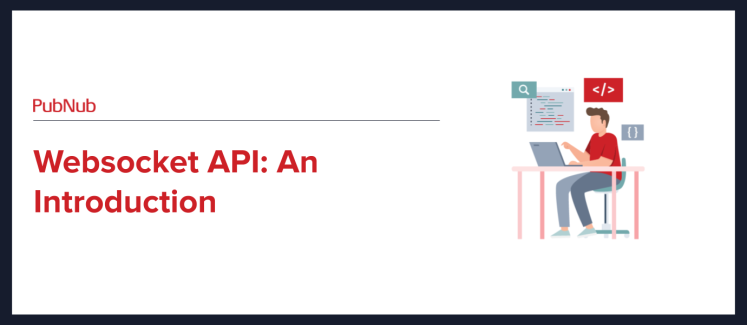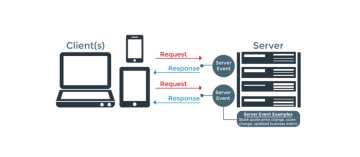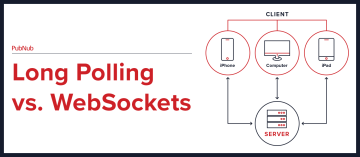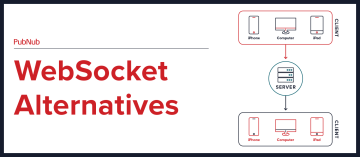
Welcome to our tutorial on websocket APIs! In this guide, we will dive into how you can utilize websocket APIs to build seamless, low-latency experiences for your users. We'll discuss the differences between websockets and websocket APIs, learn about their various use cases, and explore how PubNub can help you harness the power of websocket APIs in your applications.
Websocket APIs are essential for enabling real-time communication in modern applications. They allow for bidirectional, low-latency communication between the client and the server, making them perfect for applications like chat services, market data updates, and message routing.
What is a websocket API?
A websocket API is a specific type of API that leverages the websocket protocol for real-time, bidirectional communication between a client and a server. The main advantage of using websocket APIs over traditional REST APIs is that they offer low-latency communication, which is crucial for real-time applications.
Difference between a websocket and a websocket API
While the terms "websocket" and "websocket API" are often used interchangeably, they have distinct meanings. A websocket is a communication protocol that enables two-way communication over a single, long-lived connection. On the other hand, a websocket API is an interface that allows developers to interact with and utilize the websocket protocol in their applications.
The websocket protocol operates over the same ports as HTTP and HTTPS (ports 80 and 443, respectively) but uses the ws and wss (websocket secure) URI schemes. This allows for seamless integration with existing web infrastructures and ensures that websocket connections can pass through most firewalls and proxy servers.
Websocket APIs and API Gateways
API gateways are often used to manage and route requests to different backend services in a microservices architecture. They can handle various protocols, including REST, gRPC, and websocket APIs. When dealing with websocket APIs, the API gateway is responsible for managing websocket connections, handling authentication, and routing messages between clients and backend services.
In a typical scenario, the client would establish a websocket connection to the API gateway, which would then authenticate the client and route messages to the appropriate backend service. This setup provides a single entry point for all client connections, simplifying the management of websocket connections and ensuring consistent authentication and authorization across your application.
Next, explore how to run a websocket API and dive into some practical examples of apps that utilize websocket APIs for real-time communication.
How do I run a websocket API?
Running a websocket API involves setting up a server that supports the websocket protocol, implementing the desired functionality, and connecting clients to the server. This section will discuss the general steps to run a websocket API.
Choose a server technology: To run a websocket API, you need a server that supports the websocket protocol. Some popular server technologies include Node.js, Python, and Java. Many libraries and frameworks exist for these languages, such as Socket.IO for Node.js, simplifying websocket API implementation.
Implement the desired functionality: Depending on your application's use case, you must implement specific functionality for your websocket API. This may involve handling user authentication, managing subscriptions and routing, processing incoming messages, and sending responses to clients.
Set up websocket endpoints: Your websocket API will require one or more endpoints to which clients can connect. These endpoints are typically identified by a URL, such as
ws://localhost:8080/chat. When a client connects to this URL, the server will establish a new websocket connection and handle the communication between the client and the backend services.Implement client-side code: To connect to the websocket API, clients must implement the necessary code for establishing a websocket connection and sending and receiving messages. This typically involves using a websocket client library, such as the native WebSocket API in JavaScript.
Secure your websocket API: It's crucial to secure your websocket API with proper authentication and authorization mechanisms. This can be achieved using various strategies, such as token-based authentication, OAuth, or custom authentication solutions.
Test and monitor your websocket API: Finally, test your websocket API to ensure it's functioning correctly and monitor its performance to identify potential issues, such as high latency or dropped connections.
Examples of websocket APIs in apps
Websocket APIs are used in many applications to enable real-time communication and updates. Here are some examples of popular apps that leverage websocket APIs:
Online gaming: Websocket APIs play a crucial role in online gaming, allowing players to interact with each other and the game server in real-time. This bidirectional communication is essential for providing a seamless gaming experience with low latency, ensuring player actions are promptly reflected in the game.
Collaborative editing tools: Applications like Google Docs utilize websocket APIs to synchronize document changes between multiple users in real-time. As users edit a document, their updates are sent to the server and immediately broadcast to other connected users, ensuring everyone sees the most recent version of the document.
Real-time analytics: Websocket APIs are widely used in real-time analytics dashboards to display up-to-date metrics and data visualizations. These applications often rely on websocket connections to stream data from the server, ensuring the displayed information is always current.
Financial applications: Stock trading platforms and other financial applications use websocket APIs to provide users real-time market data and updates. This enables users to make informed decisions based on the latest information, such as stock prices or currency exchange rates.
Instant messaging and chat: Websocket APIs are the backbone of many instant messaging and chat applications, such as Slack or WhatsApp. These APIs enable users to send and receive messages in real-time, allowing for quick and efficient communication.
The following section will explore how to build real-time applications using websocket APIs.
Building real-time apps using websocket APIs
Building real-time applications with websocket APIs involves several key components, including establishing a websocket connection, managing authentication, and handling message payloads. In this section, we'll walk through the general process of building a real-time application using websocket APIs.
Establish a websocket connection: To initiate real-time communication, your application must first establish a websocket connection with the server. This involves creating a new websocket instance in your frontend code (e.g., JavaScript) and connecting to a specific server endpoint (e.g.,
wss://example.com/websocket). Make sure to handle connection lifecycle events, such as opening, closing, and error handling.Authentication: Secure your websocket connection by implementing an authentication mechanism. This often involves sending an authentication token or API key as part of the initial connection request. The server then validates this token and either accepts or rejects the connection based on the token's validity.
Message handling: Design your application to handle different message types and formats. Typically, messages are sent and received as JSON objects, which makes it easy to parse and process the payload. Ensure your application can handle various message types, such as chat messages, status updates, or user events.
Routing: Implement routing logic in your backend (e.g., Node.js) to handle incoming messages and distribute them to the appropriate recipients. This may involve subscribing and unsubscribing users from specific channels or topics and processing and forwarding messages to other connected clients.
Error handling and timeouts: Build robust error handling into your application to deal with unexpected issues, such as connection errors, authentication failures, or message processing issues. Implementing timeout mechanisms and regular "ping-pong" messages between client and server can help maintain an active connection and detect potential problems.
With these core components in place, you can build a wide range of real-time applications, from chat applications to collaborative editing tools or financial platforms. In the next section, we'll discuss how PubNub simplifies the process of building real-time applications using websocket APIs.
PubNub and websocket APIs
PubNub is a robust platform that simplifies the development of real-time applications using websocket APIs. With its extensive features and easy-to-use SDKs, PubNub allows developers to focus on their application logic. At the same time, the platform takes care of the underlying communication infrastructure, reducing latency and ensuring reliable data delivery.
Here's how PubNub fits into the narrative of building real-time applications with websocket APIs:
Scalable and reliable infrastructure: PubNub's global infrastructure provides low-latency, bidirectional communication between clients and servers, ensuring a seamless user experience. PubNub handles millions of simultaneous connections, making it suitable for various use cases, from chat applications to market data streaming and IoT solutions.
Easy-to-use SDKs: PubNub offers SDKs for various programming languages, including JavaScript, Python, and Node.js, making it easy to integrate with your frontend and backend code. The SDKs abstract the complexity of websocket connections, authentication, and message handling, allowing developers to quickly build real-time applications without worrying about the underlying details.
Real-time features: PubNub provides a host of built-in features that simplify the development of real-time applications. These include message history, presence detection, and access control, which can be easily integrated into your application with minimal additional code.
Comprehensive documentation: PubNub offers extensive documentation, including API reference, tutorials, and guides, to help you get started quickly and maximize the platform's features. Check out this developer's guide for more information on building real-time applications with PubNub.
PubNub is an ideal solution for developers building real-time applications using websocket APIs. Its robust infrastructure, easy-to-use SDKs, and comprehensive documentation make creating reliable, scalable, and feature-rich applications easy. Get started with PubNub today and take your real-time application development to the next level.


